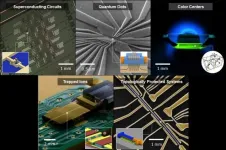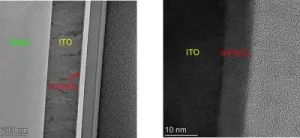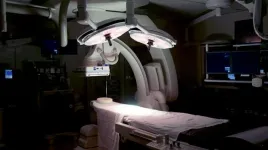(Press-News.org) PHILADELPHIA - A new gene therapy for one of the most common forms of congenital blindness was safe and improved patients' vision, according to initial data from a clinical trial led by researchers at the Scheie Eye Institute in the Perelman School of Medicine at the University of Pennsylvania.
The therapy delivers working copies of GUCY2D to the eyes of patients who have severe vision impairments caused by mutations in the gene. Each of the first three treated patients experienced improvement in some aspects of vision, without serious side effects, according to the new study, published in the journal iScience.
"We found sustained improvements in both day and night vision, even with a relatively low dose of the gene therapy," said study lead author Samuel G. Jacobson, MD, PhD, a professor of Ophthalmology in the Perelman School of Medicine.
The GUCY2D gene is one of about 25 different human genes whose mutations cause problems in the retina, leading to severe vision impairment from birth or early childhood. This family of inherited retinal disorders, collectively known as Leber congenital amaurosis (LCA), accounts for a considerable portion of blindness in children worldwide.
Normal copies of GUCY2D encode an enzyme in the key pathway that light-sensitive rod and cone cells in the retina use to convert light into electrochemical signals. A lack of this enzyme blocks the recovery of this pathway, preventing the reset needed for further signaling. As a result, the signal from rod and cone cells becomes very weak -- which equates to severe vision loss.
Even in adults who have lived for decades with this condition, it is often the case that many light-sensing retinal cells remain alive and intact despite their dysfunction. Thus, adding functional copies of GUCY2D via a gene therapy could get those cells working again and restore some vision.
In 2019, Jacobson and co-investigator Artur V. Cideciyan, PhD, a research professor of Ophthalmology in the Perelman School of Medicine, began the first clinical trial of a GUCY2D gene therapy, a solution of a harmless virus that carries the gene and is injected beneath the retina -- initially in just one eye per patient. They are following each patient for two years after treatment. In the new report, they described their findings after nine months in the first three patients treated.
The first patient experienced a substantial increase in light-sensitivity in rod cells, which are more light-sensitive than cone cells and are chiefly responsible for low-light or "night vision." This patient also showed improved pupil responses to light.
The second patient showed a smaller but sustained increase in light-sensitivity in rod cells, starting about two months after the gene therapy.
The third patient showed no improvement in rod cell sensitivity, but did show significantly improved visual acuity over the nine-month follow-up period, an improvement that the researchers tied to better function in the patient's cone cells, the predominant cells for daylight and color vision.
"These initial results from the first-ever trial of a GUCY2D gene therapy are very encouraging and will inform our ongoing and future trials of this therapy," said Cideciyan.
There were no serious adverse side effects, and any side effects that occurred in the patients' retinas resolved.
The gene therapy dose used in these first three patients was the lowest of the doses the researchers plan to use in the study, so they are hoping to see continued safety and greater efficacy in later-enrolled patients who will receive higher doses.
INFORMATION:
The ongoing clinical trial is registered at clinicaltrials.gov as trial NCT03920007.
Jacobson and Cideciyan in earlier studies have reported success for gene-based therapies against two other forms of Leber congenital amaurosis involving other genes.
Additional Penn authors included: Alexandra V. Garafalo, Alejandro J. Roman, Alexander Sumaroka, Vivian Wu, Arun K. Krishnan, and Rebecca Sheplock.
Support for the research was provided by Atsena Therapeutics Inc.
A new study outlines the need for materials advances in the hardware that goes into making quantum computers if these futuristic devices are to surpass the abilities of the computers we use today.
The study, published in the journal Science by an international team, surveyed the state of research on quantum computing hardware with the goal of illustrating the challenges and opportunities facing scientists and engineers.
While conventional computers encode "bits" of information as ones and zeroes, quantum computers breeze past this binary arrangement by creating "qubits," which can be complex, continuous quantities. Storing and manipulating information ...
JACKSONVILLE, Fla. -- In a new paper published in Nature Communications, Mayo Clinic researchers and collaborators report the protein-coding gene SERPINA5 may worsen tau protein tangles, which are characteristic of Alzheimer's disease, and advance disease. By combining clinical expertise, brain tissue samples, pathology expertise and artificial intelligence, the team clarified and validated the relevance of the gene to Alzheimer's disease.
The researchers used tissue samples from 385 brains donated to the Mayo Clinic Brain Bank, which houses more than 9,000 brain tissue specimens for the study of neurodegenerative disorders. The samples were from people who were diagnosed with Alzheimer's disease and lacked co-existing diseases found in ...
Hydrogen will be needed in large quantities as an energy carrier and raw material in the energy system of the future. To achieve this, however, hydrogen must be produced in a climate-neutral way, for example through so-called photoelectrolysis, by using sunlight to split water into hydrogen and oxygen. As photoelectrodes, semiconducting materials are needed that convert sunlight into electricity and remain stable in water. Metal oxides are among the best candidates for stable and inexpensive photoelectrodes. Some of these metal oxides also have catalytically active surfaces that accelerate the formation of hydrogen at the cathode or oxygen at the anode.
Why is rust not much better?
Research has long focused on haematite (α-Fe2O3), ...
MINNEAPOLIS - April 19, 2021 - Despite access to some of the best possible medical care in the world, Senators John McCain and Edward Kennedy both died within 18 months of their diagnosis of glioblastoma, an aggressive form of brain cancer. While this deadly outcome typifies the nature of this disease, some glioblastoma patients see exceptional benefits from chemotherapy and survive beyond expectations. Why this happens has been revealed by researchers at the University of Minnesota in a new study published in the Proceedings of the National Academy of Sciences.
"Deciphering the molecular underpinning of these exceptional ...
In March 2020, when the pandemic hit, everything slowed, including non-essential medical procedures such as elective surgeries, to reduce the spread of the coronavirus.
Six weeks later, Mary Byrnes, Ph.D., an assistant research scientist in the Department of Surgery at Michigan Medicine, began calling University of Michigan Frankel Cardiovascular Center patients whose surgeries had been canceled or delayed. She wanted to hear about their experiences -- what undergoing surgery meant to them, how postponing their operations had affected them, whether the existence of the coronavirus complicated how they felt about their bodies and ...
Psoriasis is a common inflammatory skin condition. The underlying genetic factors have not yet been sufficiently researched. The skin inflammation is usually triggered by external factors such as infections or stress. A research team at the Institute of Cancer Research of the Medical University of Vienna has now managed to identify a new factor in signal transmission of the immune system that plays a major role in the development of a psoriatic episode. The scientists have shown that symptoms can be alleviated by inhibiting the "c-Jun" protein in signal transmission.
The common clinical manifestation of psoriasis is a pinkish-grey thickening of the epidermis in distinct foci of infection, ...
It has been known for about a year that minks can become infected with SARS-CoV-2. The virus had been transmitted from humans to farmed mink and mutated in infected animals. Mutations were acquired in the spike protein, which is crucial for the entry of the virus into host cells and represents the central point of attack for antibodies. These SARS-CoV-2 variants from mink were transmitted back to humans, raising concerns that minks could be a continuing source of infection of humans with SARS-CoV-2 variants with altered biological properties. Researchers at the German Primate Center (DPZ) - Leibniz Institute for Primate Research in Göttingen, Germany, have now shown that an antibody used for COVID-19 ...
A simple dietary supplement reduces behavioral symptoms in mice with a genetic mutation that causes schizophrenia. After additional experiments, including visualizing the fluorescently stained dancing edge of immature brain cells, researchers concluded that the supplement likely protects proteins that build neurons' cellular skeletons.
The supplement betaine was first isolated from sugar beets and is often associated with sweetness or umami flavor. Healthy levels of betaine come from both external food sources and internal synthesis in the body. Betaine ...
Up to 25 percent of global food production is lost annually due to insects, primarily beetles. For the past 500 million years, beetles have successfully spread and adapted to life around the globe and now account for one of every five animal species on Earth. Yet as far back as ancient Egypt, these tough little bugs have invaded granaries and vexed us humans by destroying our crops.
As a result, food production and an abundant use of pesticides now go hand in hand. A large share of these pesticides damage biodiversity, the environment and human health. As various pesticides are phased out, new solutions are required to target and eradicate pests without harming humans or beneficial ...
Atlantic bluefin tuna have returned to UK waters and can once again be seen during the summer and autumn months.
Their numbers appear to be increasing, following a long period of absence linked to population decline, according to research led by Cefas and the University of Exeter.
Marine scientists in the UK and Ireland have analysed multiple datasets, spanning a 16-year period, to document the increase in bluefin, which arrive into the waters of the Celtic Seas and off South West England, the Scilly Isles, and North West Ireland to feed in late summer and autumn.
The research is part of the Defra-funded "Thunnus UK" research project. ...



